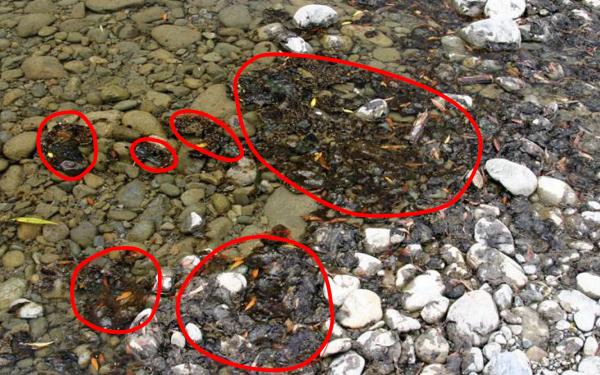Increased risk from toxic algae in the Hutt River
River users, particularly those with dogs, should be extra vigilant when visiting the Hutt and Pakuratahi rivers due to increased growth of toxic algae, says Greater Wellington Regional Council, Regional Public Health, Hutt City Council and Upper Hutt City Council.
Monitoring of the Pakuratahi River (at Hutt Forks and Farm Creek) in the popular recreational Kaitoke area shows moderate levels of detached toxic algal mats on the river's edge. The Hutt River at Silverstream Bridge, Birchville and Melling has elevated levels of toxic algae and small amounts of detached mats washing up on the river's edge.
Toxic algae, which are brown or black in colour, can kill dogs and other animals rapidly if they ingest it. Toxic algae mats that come loose and wash up on the river's edge pose the biggest risk to dogs, because as it dries it gives off a strong musty odour which dogs find irresistible. In humans, contact with toxic algae may cause skin irritations and other allergy-type symptoms. "The good news is that the risk from getting sick from the water is incredibly low. Basically, you have to eat it for it to be a problem" says Senior Science Coordinator Penny Fairbrother.
People should avoid touching it and keep a close eye on their dog to ensure it doesn't eat anything from the river's edge. If in doubt keep dogs out of the river and on a lead. They should also check the latest updates on our Facebook page and "Is it safe to swim?" website for warnings.
"The downside of recent great weather is that it creates ideal conditions for toxic algal growth in rivers. Limited rainfall and the warm dry conditions have combined to create rapid toxic algal growth earlier than expected. It's likely that toxic algae could be present to some extent along the entire Hutt River at the moment, so we encourage river users to find out what toxic algae looks like and avoid it", Greater Wellington Senior Environmental Scientist Dr Mark Heath says.
Upper Hutt City Council and Hutt City Council will be posting information signs at key access points along the river. Monitoring of popular river and beach spots in the region is carried out by the Regional Council and local authorities on a weekly basis over the summer months from 1 December to the end of March. Results of the monitoring and latest warnings are posted on www.gw.govt.nz/is-it-safe-to-swim
Other information about toxic algae, including a video of what to look for and what to do if you are worried about possible contact with toxic algae can be found at www.gw.govt.nz/toxic-algae-faqs.
Keep you and your dog safe from toxic algae this summer -
- How to spot toxic algae - toxic algae forms black or brown leathery mats on rocks in the river. If these mats become detached they form brown and black clumps at the river's edge or in parts of the river where rocks are exposed or it's shallow
- If you find toxic algae - avoid touching it. Keep your dog on a lead and make sure it doesn't eat anything from the river's edge
- If you think your dog has eaten toxic algae - take your dog to a vet immediately
- If you are concerned about symptoms following contact with toxic algae - contact your family doctor

FOR MORE INFORMATION, PLEASE CONTACT:
Penny Fairbrother
Senior Science Coordinator, Science Integration Team
Environmental Management Group
Greater Wellington Regional Council
04 830 4278, penny.fairbrother@gw.govt.nz
Dr Mark Heath
Senior Environmental Scientist, Marine and Freshwater Team
Environmental Management Group
Greater Wellington Regional Council
027 4646 030, mark.heath@gw.govt.nz
Medical Officer of Health
Regional Public Health - phone: 04 570 9002
Get in touch
- Phone:
- 0800 496 734
- Email:
- info@gw.govt.nz
